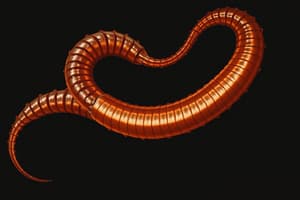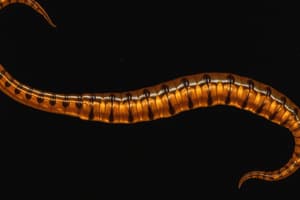Podcast
Questions and Answers
What is the primary diagnostic method for heartworm infection in dogs?
What is the primary diagnostic method for heartworm infection in dogs?
- Urinalysis
- Stool examination
- Knots/filter test (correct)
- Complete blood count
Which animals are considered intermediate hosts for Dirofilaria immitis?
Which animals are considered intermediate hosts for Dirofilaria immitis?
- Mosquitos (correct)
- Ticks
- Fleas
- Lice
What is the approximate size of Dirofilaria immitis microfilariae?
What is the approximate size of Dirofilaria immitis microfilariae?
- 300-325 x 6-7 um (correct)
- 150-175 x 5-6 um
- 250-285 x 5-5.5 um
- 200-225 x 4-4.5 um
Which of the following signs is NOT associated with heartworm infection in dogs?
Which of the following signs is NOT associated with heartworm infection in dogs?
How soon can the earliest heartworm antigen be detected post-infection?
How soon can the earliest heartworm antigen be detected post-infection?
What is the primary treatment for inflammation associated with heartworm infection in dogs?
What is the primary treatment for inflammation associated with heartworm infection in dogs?
What is the main diagnostic method for detecting Onchocerca cervicalis in horses?
What is the main diagnostic method for detecting Onchocerca cervicalis in horses?
Which clinical sign is commonly observed in animals infected with Onchocerca lupi?
Which clinical sign is commonly observed in animals infected with Onchocerca lupi?
Where are the adults of Onchocerca lupi commonly found within the host's body?
Where are the adults of Onchocerca lupi commonly found within the host's body?
Which treatment method is NOT commonly used for Onchocerca lupi infections?
Which treatment method is NOT commonly used for Onchocerca lupi infections?
In which season are horses most likely to be exposed to Culicoides, a vector for Onchocerca cervicalis?
In which season are horses most likely to be exposed to Culicoides, a vector for Onchocerca cervicalis?
What is the primary mode of transmission of Onchocerca lupi in canines, cats, and humans?
What is the primary mode of transmission of Onchocerca lupi in canines, cats, and humans?
Flashcards are hidden until you start studying
Study Notes
Heartworm Infection in Dogs
- Primary diagnostic method for heartworm infection: Immunodiagnostic tests detecting heartworm antigens.
- Approximate size of Dirofilaria immitis microfilariae: 300-330 micrometers in length.
- Earliest heartworm antigen detection: Typically 5-7 months post-infection.
- Primary treatment for inflammation: Corticosteroids to manage inflammatory response.
Intermediate Hosts
- Intermediate hosts for Dirofilaria immitis: Mosquitoes, which transmit the larvae to dogs.
Misleading Signs
- Signs NOT associated with heartworm infection: Sneezing is not a typical indicator of heartworm presence in dogs.
Onchocerca Infections
- Main diagnostic method for Onchocerca cervicalis in horses: Detection via skin biopsy or the evaluation of microfilariae in skin samples.
- Common clinical sign in animals infected with Onchocerca lupi: Ocular lesions, particularly seen in the eye.
- Adults of Onchocerca lupi are typically found: In the subcutaneous tissues or adjacent to the eyes of the host.
Treatment Methods
- Treatment method NOT commonly used for Onchocerca lupi infections: Ivermectin is less effective compared to other methods.
- Horses are mostly exposed to Culicoides, a vector for Onchocerca cervicalis, during warmer months, particularly late spring and summer.
Transmission of Onchocerca lupi
- Primary mode of transmission for Onchocerca lupi in canines, cats, and humans: By bite from infected midges (biting insects).
Studying That Suits You
Use AI to generate personalized quizzes and flashcards to suit your learning preferences.




